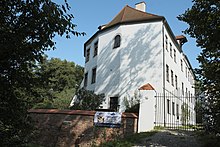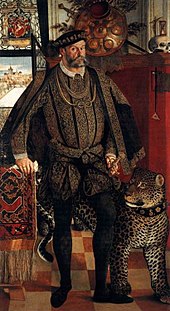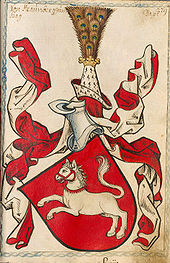Fraunberg (noble family)

Fraunberg (also Frawnperg, Frauenberg, Fraunberger, Frauenberger ) is the name of an ancient Bavarian noble family with the same ancestral seat at Fraunberg Castle (in Fraunberg , Erding district , Upper Bavaria ), which at the end of the 13th century was part of the later imperial line called "Fraunberg zu Haag" the later baronial line "from and to Fraunberg" branched out. The latter is still in bloom at the headquarters today.
history
As one of the first verifiable members of the sex, the layman Arnoldus de Frawnperg appears in a document from Bishop Otto von Freising in 1144 . The secured trunk line begins in 1231 with Sigfried von Frauenberg . Due to his marriage to the daughter of Gurren von Haag , he inherited the possessions of the Lords of Haag and received high jurisdiction for them from Emperor Friedrich II. In 1245 .
His grandchildren founded the two main lines: Sigfried III. († 1317) that of Haag , and Wittilo († 1281) that of Fraunberg .
Sigfrid III. waged a bitter war against the archbishopric of Salzburg in 1280 to end its influence in his Hague region. In 1304 he acquired Hohenburg am Inn. In 1317 he started a feud again, this time against the diocese of Freising . He had the castles Kranzberg and Burgrain stormed and the castle crews killed. His son Sigfrid IV continued the bloody feud.
Konrad I von Fraunberg was granted market rights by the later Emperor Ludwig IV in 1324 for his services in the Battle of Mühldorf . Konrad's brother Hans I acquired Prunn Castle on the Altmühl in 1338 .
Konrad II von Fraunberg tried to expand his influence outside Bavaria. For this reason he entered the service of the Dukes of Tyrol. Konrad was initially court marshal of the Duchess Margarete Maultasch and in 1354 governor of Trento. At the time, rumors of a love affair between the Duchess and him made the rounds. During his stay in Tyrol, Konrad managed to acquire extensive properties there. These included the Sarnthein Castle in the Sarntal Valley , the Ehrenburg Castle in the Puster Valley, the Persen Castle near Trient and the Penede Castle above Lake Garda, as well as the Stein Castle on Renon . After the death of Ludwig the Brandenburger , the Duchess's husband, Konrad II was captured and ousted. (A love affair with the duchess or that he is said to have murdered her husband, as claimed, for example, in the well-known novel The Ugly Duchess by Lion Feuchtwanger , could not be proven to him.) At the same time, the Wittelsbachers attacked the county of Haag in 1362 However, the Fraunbergers were able to hold their celebrations at Fraunberg near St. Christoph and Hohenburg.
In 1370 Wilhelm von Frauenberg acquired Hartmannsberg Castle as a pledge for a service debt of 6,000 pounds . It remained with him until 1380. In the same period, around 1377, the Fraunbergers acquired the Dießenstein fortress from the highly indebted Tuschl . In 1378 they sold these again to the Bavarian dukes. Wilhelm Fraunberger zum Haag came into possession of Egg Castle in 1408 . His son Irg the Younger donated an altar in the “Our Lady Chapel” in Egg. In 1427 he sold Egg for eight thousand Hungarian ducats to Duke Heinrich von Bayern-Landshut .
George III von Fraunberg zu Haag sparked the " ox war " in Lower Bavaria in 1421 . He tried to increase his power. Despite surprising military victories against Bavaria, this war brought him nothing.
In 1423 Johann von Fraunberg acquired from Landgrave Johann III. and George III. Haidenburg Castle from Leuchtenberg . With the extinction of his line in the male line in 1508, parts of the fortress fell to Alban von Closen . He succeeded in taking over the rule and the castle through purchase and further contracts.
In 1425 there was a dispute between Jörg von Fraunberg and the diocese of Freising. Jörg claimed 400 Hungarian guilders , which he had advanced for the construction. However, Freising was not prepared to pay this. Thereupon Jörg fought the Freising followers in the worst possible way. Duke Heinrich XVI. von Bayern-Landshut passed the verdict in favor of the Fraunberger in this conflict. The bishop had to pay 700 Hungarian guilders. Jörg immediately bequeathed this to his cousin Lukas von Fraunberg, as he owed him money as well. A year later Jörg received another 400 Hungarian guilders from Freising.
In 1431 Hans Fraunberg zu Haag acquired the fortress of Massenhausen Castle , which in 1499 came to the Freising Cathedral Monastery.
In 1436, the free-owned county of Haag was given to the Fraunbergers by the Kaiser as an imperial fief. The Fraunbergers hoped to be able to counter the increasing pressure of the dukes of Bavaria.
Emperor Friedrich III. In 1465 Hans the Elder, Jörg and Hans the Younger raised the Fraunberger zum Haag on irer graveschaft zum Hag to imperial barons with the right to be sealed with red wax .
In 1489, the Straubing Knights, including Wolfgang von Fraunberg zu Prunn, formed the Lion League against the Bavarian Duke Albrecht the Wise . This led to the storming of Prunn Castle by ducal riders in 1491, who then devastated the castle.
Ladislaus von Fraunberg zu Haag and his line were elevated to hereditary imperial counts in 1509 with a vote and seat on the diet.
The first class as one of the four first knights of the empire was confirmed by Emperor Charles V on April 25, 1541 in Regensburg for Christoph von Fraunburg zu Bocksau in the primogeniture . In the same year, the Fraunberger zu Haag received the right to mint.
In 1558, Count Ladislaus zu Haag introduced freedom of religion to the county. As a result, large parts of the population quickly adopted the evangelical faith. This soon led to conflicts with the Duchy of Bavaria. With the death of the count in 1566, the line of the imperial counts of Fraunberg zu Haag died out. The imperial county was given to the dukes of Bavaria by Emperor Maximilian II , who reversed the Reformation there.
Karl von Alten-Fraunburg, first emperor of the empire, was raised to the status of baron by Emperor Ferdinand II in 1630. In the Kingdom of Bavaria , the gender was registered in the baron class of nobility in 1812 .
Branches of the family still exist today.
coat of arms
Blazon : The family coat of arms shows a silver pole in red ; on the helmet is a gold-crowned, red pointed hat with an ermine cuff, in the crown a natural peacock's tail; the helmet covers are red and silver.
Coat Mehrung to 1570: The line Fraunberg to Fraunberg received after the extinction of the line Fraunberg to Haag of Kaiser Maximilian II. In 1570 the authorization to crest Mehrung with the elements ( in red a white horse ) of the stem arms of the extinct counts of Hague.
Elements ( in red a silver pole or in red a white horse ) from the coats of arms of the various lines of those von Fraunberg, which were united from 1570, still appear today individually or combined in some Bavarian local and community coats of arms.
Coat of arms of the Fraunberg community
Coat of arms of the municipality of Albaching
Coat of arms of the municipality of Laberweinting
Coat of arms of the municipality of Sankt Wolfgang
Coat of arms of the municipality of Taufkirchen (Vils)
Coat of arms of the Haag market in Upper Bavaria
General
An old tournament rhyme from the time of Emperor Sigismund reports the following:
- “Then the strict, vesten, in the beginning the Fraunbergers
- the best in Bavaria, knights of the empire without risk. "
Name bearer
- Veit von Fraunberg (*?; † 1567), Bishop of Regensburg
- Joseph Maria von Fraunberg (* 1768; † 1842), Bishop of Augsburg and Archbishop of Bamberg
Individual evidence
- ^ Entry on Hartmannsberg (Hademarsberg) in the private database "Alle Burgen".
- ^ Sale of the Dießenstein to Fraunberg
- ↑ Dießenstein from 1378 in the possession of the dukes
- ↑ Dießenstein's sale about 30 years after construction (PDF; 191 kB)
- ↑ Georg Müller: Egg Castle and its owners . Verlag M. Renner, Deggendorf 1885, p. 17f.
- ^ Conflict with Freising
- ^ Entry on Schloss Massenhausen in the private database "Alle Burgen".
- ↑ Desolation 1491
literature
- Johannes Goldner, Wilfried Bahnmüller: Early Bavarian noble families , Freilassing 1985, ISBN 3-7897-0123-8
- Gottfried Schäffer , Gregor Peda : Burgen und Schlösser im Passauer Land , 2nd edition, Freilassing 1981, ISBN 3-7897-0060-6 .
- Otto Hupp : Munich Calendar 1920. Munich / Regensburg Publishing House 1920.
- Ludwig Freiherr von und zu Fraunberg: Family tree of the gentlemen v. Fraunberg zum Hag und zu Fraunberg, 1144-1919 , Frankfurt am Main 1913 ( online ).









